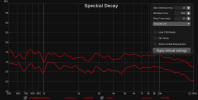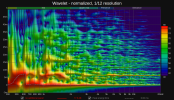Keith_W
Major Contributor
I have done a search in many other threads to find the answer to my question and learnt a lot about Spinorama measurements. From what I gather, Spinorama is more useful as a design and purchase tool. My understanding is that you want a low directivity index with early reflections, the listening window, and sound energy closely matching in shape the axial response. I have already purchased my loudspeakers, so the "design" and "purchase" aspect of interpreting Spinorama measurements is of no concern to me.
However, it got me wondering whether knowledge of the Spinorama might affect how much I should toe-in my speakers. This is a photo of my speakers from the listening position:

Not so apparent in this photo: the speakers are both toed-in so that they point slightly behind my head at the listening position.
The wide angle distortion from my camera makes the speakers look closer to the wall than they actually are. However, they are positioned well away from the wall. As a side note, I initially positioned the speakers in the room using traditional rules of loudspeaker placement and then refining the position and toe-in by ear. Today I found a loudspeaker positioning tool which confirmed that where I placed the speakers is not a problem:

So let us assume that the speakers are correctly and optimally placed in the room, and focus the questions on toe-in.
I do not own a Klippel NFS, nor do I know where I can access one or hire an anechoic chamber. I DO own an Earthworks M30 mic, mic tripod, and can use REW on my laptop. If I have to, the ONLY way to find out my speaker's off-axis response would be to take them outside and do multiple sine wave sweeps with the help of a protractor and some string. However, given the size and weight of my speaker this would require a massive effort as they weigh 110kg each.
Now, toe-ing my speakers out, but still within the listening window, would reduce the axial response and increase the early reflections, but should not change sound energy (correct me if I am wrong please). Without knowing the Spinorama measurements, is there a way to accurately measure or predict the optimal amount of toe-in? Of course, I could just experiment with toe-in and just listen and adjust to my preference (which I have already done), but I would like a more "objective" way to find out the answer.
However, it got me wondering whether knowledge of the Spinorama might affect how much I should toe-in my speakers. This is a photo of my speakers from the listening position:
Not so apparent in this photo: the speakers are both toed-in so that they point slightly behind my head at the listening position.
The wide angle distortion from my camera makes the speakers look closer to the wall than they actually are. However, they are positioned well away from the wall. As a side note, I initially positioned the speakers in the room using traditional rules of loudspeaker placement and then refining the position and toe-in by ear. Today I found a loudspeaker positioning tool which confirmed that where I placed the speakers is not a problem:
So let us assume that the speakers are correctly and optimally placed in the room, and focus the questions on toe-in.
I do not own a Klippel NFS, nor do I know where I can access one or hire an anechoic chamber. I DO own an Earthworks M30 mic, mic tripod, and can use REW on my laptop. If I have to, the ONLY way to find out my speaker's off-axis response would be to take them outside and do multiple sine wave sweeps with the help of a protractor and some string. However, given the size and weight of my speaker this would require a massive effort as they weigh 110kg each.
Now, toe-ing my speakers out, but still within the listening window, would reduce the axial response and increase the early reflections, but should not change sound energy (correct me if I am wrong please). Without knowing the Spinorama measurements, is there a way to accurately measure or predict the optimal amount of toe-in? Of course, I could just experiment with toe-in and just listen and adjust to my preference (which I have already done), but I would like a more "objective" way to find out the answer.





